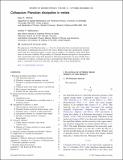Files in this item
Colloquium : Planckian dissipation in metals
Item metadata
| dc.contributor.author | Hartnoll, S.A. | |
| dc.contributor.author | MacKenzie, A.P. | |
| dc.date.accessioned | 2023-01-31T16:30:08Z | |
| dc.date.available | 2023-01-31T16:30:08Z | |
| dc.date.issued | 2022-11-30 | |
| dc.identifier | 282894992 | |
| dc.identifier | d5c1c46c-02f4-4d12-8ecd-8a5ce36420c7 | |
| dc.identifier | 85145346738 | |
| dc.identifier | 000893168000001 | |
| dc.identifier.citation | Hartnoll , S A & MacKenzie , A P 2022 , ' Colloquium : Planckian dissipation in metals ' , Reviews of Modern Physics , vol. 94 , no. 4 , 041002 . https://doi.org/10.1103/RevModPhys.94.041002 | en |
| dc.identifier.issn | 0034-6861 | |
| dc.identifier.other | RIS: urn:8B14DB0371AB8243E448EECC16B818BC | |
| dc.identifier.uri | https://hdl.handle.net/10023/26867 | |
| dc.description | Funding: The work of S. A. H. was partially supported by U.S. DOE Award No. DE-SC0018134, by Simons Investigator Grant No. 620869, and by STFC Consolidated Grant No. ST/T000694/1. A. P. M. acknowledges the support of the Max Planck Society. | en |
| dc.description.abstract | The appearance of the Planckian time τP1=ℏ/kBT is reviewed in both conventional and unconventional metals. A pedagogical discussion of the various different timescales (quasiparticle, transport, many-body) that characterize metals is given, with an emphasis on conditions under which these times are the same or different. The possibility of a Planckian bound on dissipation is discussed from both a quasiparticle and a many-body perspective. Planckian quasiparticles can arise naturally from a combination of inelastic scattering and mass renormalization. Many-body dynamics, on the other hand, is constrained by the basic timescales and length scales of local thermalization. | |
| dc.format.extent | 27 | |
| dc.format.extent | 1118036 | |
| dc.language.iso | eng | |
| dc.relation.ispartof | Reviews of Modern Physics | en |
| dc.subject | QC Physics | en |
| dc.subject | TK Electrical engineering. Electronics Nuclear engineering | en |
| dc.subject | MCC | en |
| dc.subject | NCAD | en |
| dc.subject | AC | en |
| dc.subject.lcc | QC | en |
| dc.subject.lcc | TK | en |
| dc.title | Colloquium : Planckian dissipation in metals | en |
| dc.type | Journal item | en |
| dc.contributor.institution | University of St Andrews. School of Physics and Astronomy | en |
| dc.contributor.institution | University of St Andrews. Condensed Matter Physics | en |
| dc.identifier.doi | https://doi.org/10.1103/RevModPhys.94.041002 | |
| dc.description.status | Peer reviewed | en |
This item appears in the following Collection(s)
Items in the St Andrews Research Repository are protected by copyright, with all rights reserved, unless otherwise indicated.

